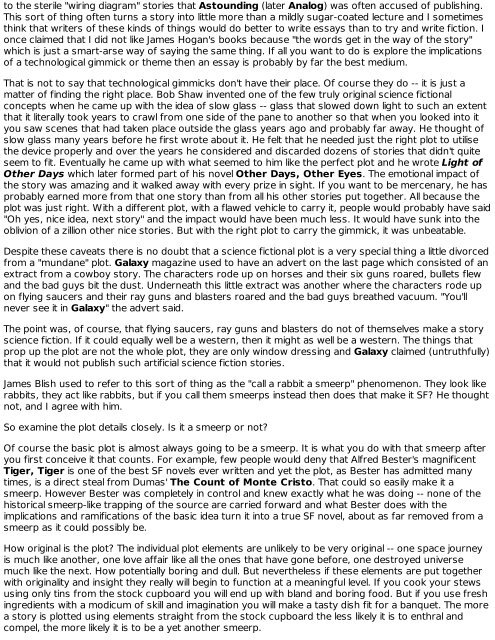Triffids Beard 2 - The Bearded Triffid
Triffids Beard 2 - The Bearded Triffid
Triffids Beard 2 - The Bearded Triffid
Create successful ePaper yourself
Turn your PDF publications into a flip-book with our unique Google optimized e-Paper software.
to the sterile "wiring diagram" stories that Astounding (later Analog) was often accused of publishing.<br />
This sort of thing often turns a story into little more than a mildly sugar-coated lecture and I sometimes<br />
think that writers of these kinds of things would do better to write essays than to try and write fiction. I<br />
once claimed that I did not like James Hogan's books because "the words get in the way of the story"<br />
which is just a smart-arse way of saying the same thing. If all you want to do is explore the implications<br />
of a technological gimmick or theme then an essay is probably by far the best medium.<br />
That is not to say that technological gimmicks don't have their place. Of course they do -- it is just a<br />
matter of finding the right place. Bob Shaw invented one of the few truly original science fictional<br />
concepts when he came up with the idea of slow glass -- glass that slowed down light to such an extent<br />
that it literally took years to crawl from one side of the pane to another so that when you looked into it<br />
you saw scenes that had taken place outside the glass years ago and probably far away. He thought of<br />
slow glass many years before he first wrote about it. He felt that he needed just the right plot to utilise<br />
the device properly and over the years he considered and discarded dozens of stories that didn't quite<br />
seem to fit. Eventually he came up with what seemed to him like the perfect plot and he wrote Light of<br />
Other Days which later formed part of his novel Other Days, Other Eyes. <strong>The</strong> emotional impact of<br />
the story was amazing and it walked away with every prize in sight. If you want to be mercenary, he has<br />
probably earned more from that one story than from all his other stories put together. All because the<br />
plot was just right. With a different plot, with a flawed vehicle to carry it, people would probably have said<br />
"Oh yes, nice idea, next story" and the impact would have been much less. It would have sunk into the<br />
oblivion of a zillion other nice stories. But with the right plot to carry the gimmick, it was unbeatable.<br />
Despite these caveats there is no doubt that a science fictional plot is a very special thing a little divorced<br />
from a "mundane" plot. Galaxy magazine used to have an advert on the last page which consisted of an<br />
extract from a cowboy story. <strong>The</strong> characters rode up on horses and their six guns roared, bullets flew<br />
and the bad guys bit the dust. Underneath this little extract was another where the characters rode up<br />
on flying saucers and their ray guns and blasters roared and the bad guys breathed vacuum. "You'll<br />
never see it in Galaxy" the advert said.<br />
<strong>The</strong> point was, of course, that flying saucers, ray guns and blasters do not of themselves make a story<br />
science fiction. If it could equally well be a western, then it might as well be a western. <strong>The</strong> things that<br />
prop up the plot are not the whole plot, they are only window dressing and Galaxy claimed (untruthfully)<br />
that it would not publish such artificial science fiction stories.<br />
James Blish used to refer to this sort of thing as the "call a rabbit a smeerp" phenomenon. <strong>The</strong>y look like<br />
rabbits, they act like rabbits, but if you call them smeerps instead then does that make it SF? He thought<br />
not, and I agree with him.<br />
So examine the plot details closely. Is it a smeerp or not?<br />
Of course the basic plot is almost always going to be a smeerp. It is what you do with that smeerp after<br />
you first conceive it that counts. For example, few people would deny that Alfred Bester's magnificent<br />
Tiger, Tiger is one of the best SF novels ever written and yet the plot, as Bester has admitted many<br />
times, is a direct steal from Dumas' <strong>The</strong> Count of Monte Cristo. That could so easily make it a<br />
smeerp. However Bester was completely in control and knew exactly what he was doing -- none of the<br />
historical smeerp-like trapping of the source are carried forward and what Bester does with the<br />
implications and ramifications of the basic idea turn it into a true SF novel, about as far removed from a<br />
smeerp as it could possibly be.<br />
How original is the plot? <strong>The</strong> individual plot elements are unlikely to be very original -- one space journey<br />
is much like another, one love affair like all the ones that have gone before, one destroyed universe<br />
much like the next. How potentially boring and dull. But nevertheless if these elements are put together<br />
with originality and insight they really will begin to function at a meaningful level. If you cook your stews<br />
using only tins from the stock cupboard you will end up with bland and boring food. But if you use fresh<br />
ingredients with a modicum of skill and imagination you will make a tasty dish fit for a banquet. <strong>The</strong> more<br />
a story is plotted using elements straight from the stock cupboard the less likely it is to enthral and<br />
compel, the more likely it is to be a yet another smeerp.


